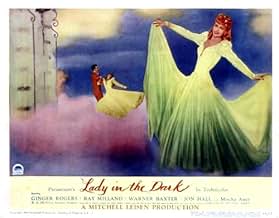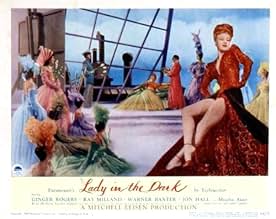CALIFICACIÓN DE IMDb
5.9/10
609
TU CALIFICACIÓN
Agrega una trama en tu idiomaLiza Elliott, "Allure" magazines editor-in-chief, suffers from headaches and continuous daydreams and undergoes psychoanalysis to determine why.Liza Elliott, "Allure" magazines editor-in-chief, suffers from headaches and continuous daydreams and undergoes psychoanalysis to determine why.Liza Elliott, "Allure" magazines editor-in-chief, suffers from headaches and continuous daydreams and undergoes psychoanalysis to determine why.
- Dirección
- Guionistas
- Elenco
- Nominado a 3 premios Óscar
- 1 premio ganado y 3 nominaciones en total
Opiniones destacadas
Liza (Ginger Rogers) is the editor of a magazine who can no longer make decisions. She suffers headaches because she is highly strung about work and she has a love life that she is not comfortable with. Through psychoanalysis with Dr Brooks (Barry Sullivan), she unravels her troubles by recounting 3 dream sequences. Can she regain her decisiveness?
This film is a bit girly in that it concerns one woman's journey to discover lost memories and understand her behaviours. It has great colour, good costumes and it's well acted with a spattering of humour throughout. The bulk of the film comes in the form of dream sequences which are musical, colourful and surreal. The 2nd sequence has a pointless dance scene which drags on a bit but overall the dreams are entertaining. The rest of the film follows the romances that Liza has alongside her role as a tough "boss lady". The film is fun and has a happy ending.
This film is a bit girly in that it concerns one woman's journey to discover lost memories and understand her behaviours. It has great colour, good costumes and it's well acted with a spattering of humour throughout. The bulk of the film comes in the form of dream sequences which are musical, colourful and surreal. The 2nd sequence has a pointless dance scene which drags on a bit but overall the dreams are entertaining. The rest of the film follows the romances that Liza has alongside her role as a tough "boss lady". The film is fun and has a happy ending.
A Technicolor spectacular, with costumes and wonderful sets to match, but the story isn't much, mostly what you might expect to read in Popular Psychoanalysis magazine.
Best are the dream and reverie sequences, especially the trial in the circus ring. These are where the singing and dancing is, but there is not much and what little there is is not very exciting.
Best are the dream and reverie sequences, especially the trial in the circus ring. These are where the singing and dancing is, but there is not much and what little there is is not very exciting.
The lady is in the 'dark' about being a lesbian. Oh why can't somebody just say it. I guess you could on Broadway and with Gertrude Lawrence in 1940 but at Paramount in '44 with Ginger, well, she just had to stay in the dark and have repressed sexual dreams about her fur in a cage and her eggs at a circus (see the Jenny number) ... and see that dress she unfurls.. a vagina representation of ever I saw one on a movie screen that wasn't x rated. In this ultra glamorous dreamy musical film Ginger is a business woman in business attire (read: lesbian .....) and she is tormented between her real business and society's demands that she marry and be with a man. Hence dilemma, dreams and fur openings and the egg circus (see the Jenny number) ... the storyline demands she relate to a man when she does not want to hence the dream sequences of antagonism and sexual wonderings. Ray Milland is the sop she is deemed to marry when anyone from this century can see she really wants to stay in a women's world and stop being a frustrated big angry prowling pussy in a cage (see the Jenny number) .... Kurt Weill knew what he was on about and so do we... but Paramount, in masking it for the masses in '44 pushed the pussycat into the fantasy sequences, hired a gay director and let loose on the dreams and shot the lot in the best most stylish Technicolor you ever saw outside of YOLANDA AND THE THIEF and THE PIRATE. In this according to Paramount, all Ginger needed was a jolly good roger.... ing.....
I found this to be moderately enjoyable and much smoother than I was expecting, after reading of all the problems in making it and the cutting of musical numbers from the original score. Would love to see it as was originally intended (in a restored DVD version).
The psychoanalysis as it unfolds is interesting and makes sense, except to the point of the woman needing to be dominated by the man. I don't know if this was dictated by the culture of the time, but all that was really needed was for Liza to know she needed to give time to gaining fulfillment in a relationship (without the aspect of dominance) and not be so driven work wise (her substitute), and it would have come out without the nasty taste it leaves now (in regards to this aspect of the film).
Director Mitchell Leisen dealt with this sort of theme also (without the psychoanalysis) in Take a Letter Darling which was funnier and sharper, and without the need for the man to have to dominate the woman.
Some of the visual imagery in the dream sequences is a lot of fun and apparently a lot of care was put into their production.
As well the movie seems like it is a 50s product but that could just be the colour.
The psychoanalysis as it unfolds is interesting and makes sense, except to the point of the woman needing to be dominated by the man. I don't know if this was dictated by the culture of the time, but all that was really needed was for Liza to know she needed to give time to gaining fulfillment in a relationship (without the aspect of dominance) and not be so driven work wise (her substitute), and it would have come out without the nasty taste it leaves now (in regards to this aspect of the film).
Director Mitchell Leisen dealt with this sort of theme also (without the psychoanalysis) in Take a Letter Darling which was funnier and sharper, and without the need for the man to have to dominate the woman.
Some of the visual imagery in the dream sequences is a lot of fun and apparently a lot of care was put into their production.
As well the movie seems like it is a 50s product but that could just be the colour.
For just three minutes towards the end of this overproduced travesty of Moss Hart's 1941 Broadway hit we finally get a hint of what might have been, when Ginger Rogers (a coarse substitute for Gertrude Lawrence, who declined to submit to the indignity of testing for the part) is finally allowed to sing a song from Kurt Weill & Ira Gershwin's acclaimed score - the magnificent 'Saga of Jenny' - the only song from the original production to make it into the film. (The flashbacks to her childhood and youth that follow actually manage to be quite touching.)
At $2.6million the most expensive film yet made by Paramount, at the box office the studio received a handsome return on its investment. But the hectoring misogyny that makes this film almost unwatchable today is probably just one reason that nobody has ever bothered to do a decent restoration of the film, so we really don't get the full benefit of the Oscar-nominated Technicolor photography and art direction that wowed critics and audiences back in 1944.
Ray Milland is excruciatingly misused as a charmless boor who Ginger is required by the script eventually to fall into the arms of (Cary Grant might just have pulled it off), and her rejection of Warner Baxter and Jon Hall for being insufficiently Alpha is just another twist of the knife of the already unpleasant sexual politics of this piece. (Ginger, by the way, actually looks pretty cool to my eyes in her 'unattractive' mannish suits.)
But at least we don't get Danny Kaye's mugging from the Broadway original as the camp fashion photographer Russell Paxton (Mischa Auer is a far more agreeable substitute), and are spared his 'hilarious' patter song 'Tschaikowsky (and Other Russians)'.
Mary Phillips does her best in an underwritten part (as indeed are most of them). Edward Fielding, by the way, who plays Ginger's physician in the opening sequence, also appeared uncredited as Dr. Edwardes in the dream sequence of Hitchcock's 'Spellbound' (1945), Hollywood's other high profile exercise in cod psychology from this era.
At $2.6million the most expensive film yet made by Paramount, at the box office the studio received a handsome return on its investment. But the hectoring misogyny that makes this film almost unwatchable today is probably just one reason that nobody has ever bothered to do a decent restoration of the film, so we really don't get the full benefit of the Oscar-nominated Technicolor photography and art direction that wowed critics and audiences back in 1944.
Ray Milland is excruciatingly misused as a charmless boor who Ginger is required by the script eventually to fall into the arms of (Cary Grant might just have pulled it off), and her rejection of Warner Baxter and Jon Hall for being insufficiently Alpha is just another twist of the knife of the already unpleasant sexual politics of this piece. (Ginger, by the way, actually looks pretty cool to my eyes in her 'unattractive' mannish suits.)
But at least we don't get Danny Kaye's mugging from the Broadway original as the camp fashion photographer Russell Paxton (Mischa Auer is a far more agreeable substitute), and are spared his 'hilarious' patter song 'Tschaikowsky (and Other Russians)'.
Mary Phillips does her best in an underwritten part (as indeed are most of them). Edward Fielding, by the way, who plays Ginger's physician in the opening sequence, also appeared uncredited as Dr. Edwardes in the dream sequence of Hitchcock's 'Spellbound' (1945), Hollywood's other high profile exercise in cod psychology from this era.
¿Sabías que…?
- TriviaThis was one of the first films to use the word "sex." Ray Milland says, "Rage is a pretty good substitute for sex, isn't it?"
- Citas
Russell Paxton: "This is the end! The absolute end!"
- Créditos curiososAt the start of the film the Paramount logo is set at night, in the dark.
At the end of the film the Paramount logo is seen at dawn, come into the light.
- ConexionesReferenced in Libros Famosos (1946)
- Bandas sonorasMain Title
Music by James Jimmy Van Heusen and Lyrics by Johnny Burke
Performed by the Paramount Studio Orchestra and Chorus
Selecciones populares
Inicia sesión para calificar y agrega a la lista de videos para obtener recomendaciones personalizadas
- How long is Lady in the Dark?Con tecnología de Alexa
Detalles
- Fecha de lanzamiento
- País de origen
- Idioma
- También se conoce como
- Lady in the Dark
- Locaciones de filmación
- Productora
- Ver más créditos de la compañía en IMDbPro
- Tiempo de ejecución1 hora 40 minutos
- Relación de aspecto
- 1.37 : 1
Contribuir a esta página
Sugiere una edición o agrega el contenido que falta



































